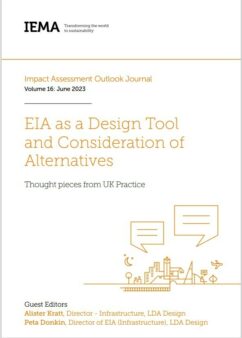IA Outlook Journal Volume 16: EIA as a Design Tool and Consideration of Alternatives

I am delighted to have been asked to be a Guest Editor, along with my colleague Peta Donkin, for the latest IEMA Impact Assessment Outlook Journal looking at EIA as a Design Tool and Consideration of Alternatives. The journal brings together a collection of articles on the importance of design and the Environmental Impact Assessment (EIA) process, defining and securing project outcomes and the role of EIA coordinators. A number of the articles explore the consideration of alternatives as part of the EIA process, including the implications of the emerging Environmental Outcomes Report Regulations.
The opening conversation with Sadie Morgan serves to open our minds and draw attention to a future outlook that is considered and pared back. Sadie makes clear that EIA professionals are key to supporting the drive towards wider regenerative outcomes, that there needs to be stronger leadership and a shift in values, and more understanding of what building sustainably means and the opportunities that brings, and that people want to feel genuinely embedded in the process of change, never excluded. Finally, she makes it clear that design requires rigour and process, and good outcomes never come out of haphazard thinking.
In the first article, ‘Our most precious asset’, Katie Medcalf draws attention to the need for EIA practitioners and project designers to understand the most precious asset we have been given—the natural environment we inhabit. Katie describes how our environment functions as a dynamic and interconnected system and highlights the benefits of integrating design with scientific evidence and modelling as part of alternative site assessment and the development proposals at the early stages of design.
Jeremy Randall, in his article ‘Positive outcomes’, identifies that there is no standard best practice methodology for site selection or national environmental baseline to inform the assessment of effects. He goes on with clarity to explore the virtues of an ‘outcomes-focused approach’ to site selection allowing for the achievement of positive environmental outcomes in contrast to an ‘effect-focused approach’.
Ed Hargreaves’ article ‘Good data, good behaviour, good principles’ draws our attention to the Environmental Outcomes Report (EOR) Regulations that present a foundation for an outcomes-based approach for EIA. It is clear that the Regulations present a significant challenge to present-day practice in relation to alternatives. This emerging change brings into sharp focus that EIA should inform good decision-making throughout the development of a project that will realise beneficial outcomes for people and the environment rather than merely comprise a report of effects arising from a project proposal recorded at the end of a project process.
In ‘EIA as Environmental Design’, Hanne Larsson makes clear that EIA professionals need to understand the future environment and the role of an EIA coordinator to drive interdisciplinary behaviour—be courageous in challenging the team, accept that assessment needs to alter to properly address our changing environment, that there needs to be space for design change to be considered—and calls for EIA coordinators to act as Environmental Designers fostering a collaborative and interdisciplinary environment.
‘Fixity and adaptive design’ is the subject of Matthew Fox’s article, which addresses a common question, ‘how is this assessment outcome or assumption secured?’ He outlines the risks associated with an ‘indicative’ Environmental Masterplan which are often considered to show one way in which mitigation could be delivered but notes that there remains a risk that this masterplan approach becomes a vehicle to illustrate all mitigation solutions. He identifies that the EIA process has a key role to play in ensuring these risks don’t come to fruition and the need to allow for adaptive mitigation and clear articulation of document status and project description.
In Sam Griffiths’ article ‘Strategic data and design principles’, Sam outlines how assessment of alternatives could be better informed and justified by the provision of strategic environmental data and founded on project-specific design principles to objectively and persuasively reason that a proposed development is the right design for a development and is in the right place.
In the final article, ‘Towards a positive outcome’, Robert Pile outlines how we can use the shift in narratives to ‘outcomes’ from ‘impact’, to empower engagement from impact assessors in the design process and move towards a more holistic approach and action that exerts influence on the way a ‘thing turns out’. A change that will put the proper consideration of the receiving environment and the design process at the forefront of all the plans and projects. Robert concludes that it is an EIA coordinator’s responsibility to empower technical specialists to engage in the project design process to affect change to project outcomes.
Turning to the conversation with Julia King, I am struck by the urgency of the issues we face and what is already upon us. It is clear we need to think about design resilience and environmental and project adaptation as our environment and climate inevitably continue to change until our actions to arrest and better manage change take effect. The most precious asset we have been given needs to be properly understood and the communities of which we are a part need to be given the respect they are rightly due in the projects and plans we seek to promote. We need to de-silo our thinking and advise and act for the better good.
I believe that we are standing on the edge of a point of significant change in best practice and societal expectation. I believe IEMA should consider the preparation of new practitioner guidance to develop some of the key issues outlined in these excellent articles: we need to address guidance on an outcomes-based approach to assessment; the establishment of an agreed approach to alternatives; refresh the description of what constitutes a design process and where EIA fits; and provide direction on sourcing and defining outcomes.
I spoke about the possible addition of an 18th UN Sustainable Development Goal at the 2023 NSIP Conference— ‘I/We’. So much of what now matters in delivery of sustainable outcomes relies on our behavioural change from national government to the individual. We all have a part to play.
--
If you have found this collection of papers useful and thought-provoking, please check the IEMA website for future events that may be linked to the themes explored in the journal.
Book your place at our launch webinar here.
If you are interested in being involved in an IEMA Working Group, IEMA members can email [email protected] to express an interest in joining a group.
Download a copy of the Outlook Journal here.
About the Guest Editors:

Alister Kratt Director - Infrastructure, LDA Design BA (Hons)
Alister is a Director of LDA Design and is a landscape architect, masterplanner and spatial planner with 30 years’ consultancy experience. He is a regular speaker on design process and infrastructure design and was a TEDx speaker at the Royal Society Whitehall series on infrastructure legacy. He has contributed to round table sessions on infrastructure to support policy development, presented to the Hendry Review and undertook a peer review of the NIC’s design principles.
His projects have received a number of awards including the Landscape Institute Presidents’ Award in 2014. He was lead author of IEMA guidance on the value of good design and its role in EIA process. Alister led the first NSIP project in the UK and is a recognised expert in DCO projects and projects of scale. He sat on HS2’s first Design Panel, is a panel member of the Design Commission for Wales and advisor to local authorities on complex developments of scale. Recent major projects include masterplan lead for Heathrow West alternative airport expansion, HS2 Euston Station and several large solar projects. He is design lead for Sizewell C and also advisor on several new community projects.

Peta Donkin, Director of EIA (Infrastructure), LDA Design
Peta is Director of EIA and Infrastructure and Energy lead at LDA Design. She is an environmental planner with over 20 years’ experience in coordinating and delivering projects ranging from initial project development through to delivery of T&CPA and Nationally Significant Infrastructure Projects, with vast experience in renewable energy and large-scale infrastructure.
She delivers strategic and technical project advice to shape and deliver strong, innovative projects which are influenced by, and tailored to, the environment, with a view to achieving positive outcomes. She was the EIA Lead for the Longfield Solar and BESS DCO, and is the EIA Lead for the Mallard Pass Solar.
--
Please note: the views expressed in this blog are those of the individual contributing member and are not necessarily representative of the views of IEMA or any professional institutions with which IEMA is associated.
Subscribe
Subscribe to IEMA's newsletters to receive timely articles, expert opinions, event announcements, and much more, directly in your inbox.
